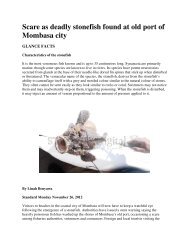Preliminary lists of Swahili names for fishes of the western Indian ...
Preliminary lists of Swahili names for fishes of the western Indian ...
Preliminary lists of Swahili names for fishes of the western Indian ...
You also want an ePaper? Increase the reach of your titles
YUMPU automatically turns print PDFs into web optimized ePapers that Google loves.
"1 I' ...... \"<br />
<strong>the</strong> middle <strong>of</strong> <strong>the</strong> twenty-first century, only fifty years<br />
on, <strong>the</strong> culture <strong>of</strong>central <strong>Swahili</strong>land will probably be<br />
no more alive - although <strong>the</strong> sadness <strong>of</strong> culture death<br />
in central <strong>Swahili</strong>land is s<strong>of</strong>tened somewhat by <strong>the</strong><br />
continuity <strong>of</strong> culture in nor<strong>the</strong>rn and sou<strong>the</strong>rn<br />
<strong>Swahili</strong>land, <strong>for</strong> a while at least. Undoubtedly <strong>the</strong><br />
pseudo-<strong>Swahili</strong> now spoken by millions as a second<br />
language will spread far and wide, but it will not be<br />
<strong>the</strong> <strong>Swahili</strong> tongue <strong>of</strong> <strong>the</strong> <strong>Swahili</strong> people. While not a<br />
creole language, pseudo-<strong>Swahili</strong> is increasingly<br />
conditioned by English syntax (or so it seems to me),<br />
is bereft <strong>of</strong> <strong>the</strong> cultural conventions accumulated over<br />
a millennium, and lacks <strong>the</strong> charm and humour and<br />
finesse <strong>of</strong> <strong>the</strong> original.<br />
A recent phenomenon relating to <strong>the</strong> whole <strong>of</strong> <strong>the</strong><br />
<strong>Swahili</strong> coast is that fishermen who are not nativespeakers<br />
<strong>of</strong> <strong>Swahili</strong> - both from <strong>the</strong> east African<br />
interior and from as far afield as Japan and Korea - are<br />
now fishing east African waters, while <strong>the</strong> wholesale<br />
marketing <strong>of</strong> sea-fish is mainly in <strong>the</strong> hands <strong>of</strong> non<br />
<strong>Swahili</strong> entrepreneurs.1> For various reasons it seems<br />
probable that <strong>the</strong> number <strong>of</strong> <strong>Swahili</strong> fishermen will<br />
continue to decline.? Lexically, this points to <strong>the</strong><br />
probability that as time goes by <strong>the</strong>re will be fewer<br />
and fewer <strong>Swahili</strong> intimate with <strong>the</strong> <strong>Swahili</strong> <strong>names</strong> <strong>for</strong><br />
marine <strong>fishes</strong>.<br />
This publication is intended <strong>for</strong> both lexicographers<br />
and marine biologists. Much ef<strong>for</strong>t has been expended<br />
to make <strong>the</strong>se <strong>lists</strong> as complete as possible, yet no one<br />
is more aware than <strong>the</strong> compiler just how incomplete<br />
<strong>the</strong>y are in <strong>the</strong>ir present <strong>for</strong>m. Sacleux is particularly<br />
strong on fish <strong>names</strong> from <strong>the</strong> Mrima coast (extending<br />
from Vanga to Kilwa, approximately). Fish <strong>names</strong> from<br />
maSiwani '<strong>the</strong> eomoro Islands' (in <strong>the</strong> speech <strong>of</strong> <strong>the</strong><br />
Comoros known as kiNgazija) remain to be collected,<br />
and also from <strong>the</strong> Baml.Qir coast (a region whose<br />
<strong>Swahili</strong>-speaking communities have been displaced<br />
sinee <strong>the</strong> 1970s due to civil strife amongst <strong>the</strong><br />
dominant Somali-speaking population). The sections<br />
which deal with shark and crab are at a preliminary<br />
stage only. As is demonstrated in <strong>the</strong> following<br />
6<br />
A discussion relating to <strong>the</strong> destruction <strong>of</strong> <strong>the</strong> marine<br />
habitat by overfishing, explosives, and pollution falls<br />
outside <strong>the</strong> scope <strong>of</strong> this introduction.<br />
The decline in <strong>the</strong> number <strong>of</strong> <strong>Swahili</strong> fishermen is<br />
accompanied by a decline in <strong>the</strong> number <strong>of</strong> <strong>Swahili</strong><br />
engaged in o<strong>the</strong>r traditional economic occupations; <strong>the</strong><br />
consequences <strong>for</strong> an already impoverished people are<br />
serious indeed.<br />
sections, <strong>Swahili</strong> lexicographers, Sacleux excepted,<br />
have shown <strong>the</strong>mselves to be inadequate in <strong>the</strong> matter<br />
<strong>of</strong>compiling <strong>the</strong> <strong>names</strong> <strong>of</strong> marine <strong>fishes</strong>. Surely, <strong>the</strong>n,<br />
<strong>the</strong> lexicographers will have been inadequate in o<strong>the</strong>r<br />
registers too, and will continue to be, unless and until<br />
<strong>the</strong>ir target language be ki<strong>Swahili</strong> eha kiSwal!ili<br />
'<strong>Swahili</strong> <strong>Swahili</strong>', <strong>the</strong> speech <strong>of</strong> <strong>the</strong> <strong>Swahili</strong> people.<br />
Alas <strong>the</strong> core <strong>of</strong> <strong>the</strong> language is steadily contracting,<br />
but <strong>the</strong>re seems to be no shortage <strong>of</strong> students who<br />
pursue projects and researches at <strong>the</strong> ever-expanding<br />
circumference. These <strong>lists</strong> have been compiled by one<br />
who is not trained as a biologist, and so <strong>the</strong> reader<br />
should not anticipate a fish taxonomic publication.<br />
What this publication does provide is, as <strong>the</strong> title<br />
indicates, preliminary <strong>lists</strong> <strong>of</strong><strong>Swahili</strong> <strong>names</strong> <strong>for</strong> <strong>fishes</strong><br />
<strong>of</strong> <strong>the</strong> <strong>western</strong> <strong>Indian</strong> Ocean, toge<strong>the</strong>r with related<br />
topics. May additions and corrections be made to<br />
<strong>the</strong>se <strong>lists</strong> while <strong>the</strong>re is yet time.<br />
The work is divided into seven sections, as follows:<br />
lchthyonymy and <strong>names</strong> <strong>for</strong> o<strong>the</strong>r marine<br />
creatures I<br />
chiefly bony <strong>fishes</strong> I (a)<br />
cartilaginolls <strong>fishes</strong> I (b)<br />
sea-turtles I (c)<br />
crabs and lobsters I (d)<br />
marine mammals I (e)<br />
Anatomy II<br />
Halieutics III<br />
Literature IV<br />
Lieitness V<br />
In <strong>the</strong> kitchen VI<br />
Fabulous marine creatures VII.<br />
The regional varieties <strong>of</strong><strong>Swahili</strong> referred to in <strong>the</strong> text<br />
arc as follows:<br />
DN nor<strong>the</strong>rn and central dialects:<br />
(<strong>the</strong> islands and <strong>the</strong> coast from Gasi<br />
northwards, to <strong>the</strong> shores <strong>of</strong> sou<strong>the</strong>rn<br />
Somaliland).<br />
DS sou<strong>the</strong>rn dialects:<br />
(<strong>the</strong> islands and <strong>the</strong> coast from Gasi<br />
southwards, to <strong>the</strong> shores <strong>of</strong> nor<strong>the</strong>rn<br />
Msumbiji [Mozambique]).<br />
kiA kiAmu, <strong>the</strong> dialect <strong>of</strong> Amu town, on <strong>the</strong><br />
island <strong>of</strong> <strong>the</strong> same name (Lamu in Arabic<br />
and English).<br />
kiB kiBanagiri, <strong>the</strong> dialect <strong>of</strong> <strong>the</strong> <strong>Swahili</strong>speaking<br />
communities along <strong>the</strong> sou<strong>the</strong>rn
" ,<br />
LETHRINIDAE.<br />
ch 'angll chole: see under l 'angll.<br />
ch 'angll dizi: nom d'un poisson de mer (S<br />
169).<br />
nor<strong>the</strong>rn kiMr.<br />
CH8 chatota (za-):<br />
kiG.<br />
CLUPEIDAE.<br />
Petit poisson mann du genre dagaa (S<br />
135).<br />
CH9 chawa:<br />
Nom d'un poisson de mer. '1Syn chaa (S<br />
136).<br />
CH 10 chaza: oyster; see nyama/a, shaza.<br />
OS<br />
OSTREI[)AE.<br />
CH 11 II chaza: remora or shark-sucker.<br />
DS; see (aza.<br />
ECHENEIDAE.<br />
CH12 chazanda (ma- or inv.): mangrove red<br />
snapper, river snapper (Llltjanlls<br />
argen/imacula/lIs); see /azanda.<br />
kiMr.<br />
LUTJANIDAE.<br />
LUTJANUS ARGENTIMACULATUS (River Snapper)<br />
CH I3 cheche: frogfish (An/ennariolls sp.).<br />
DS; kiP'emba cheche or mcheshe. kiMv sese.<br />
ANTENNARIIDAE.<br />
Un poisson de mer, I'antennaire ou<br />
chironectc (S 136).<br />
cheche-ngllre.<br />
CH 14 ch'ena: mud bream, picnic seabream<br />
(Acan/hopagnts herda) - and not as in Krapf<br />
(see below).<br />
kiMv & kiG; kiMalindi and DS / 'lIkll.<br />
SPARIDAE.<br />
A kind <strong>of</strong> shell-fish ['1] (K 37).<br />
CH 15 ch'cndc: see I 'elll/e.<br />
kiG.<br />
TERAPONIDAE.<br />
CH 16 chenje-vule: batfish'1 (P/a/ax sp.)'1<br />
kiMr; also seejogoo mWC:'lIsi &jIlIlIlSi.<br />
EPHIPPIDAE'1<br />
Nom d'un poisson de mer, la ehauvesouris<br />
de mer: slIra yake kama popo, ana<br />
miiha ki/la pahali (S 139) 'name <strong>of</strong> a sea-fish,<br />
<strong>the</strong> sea-hat: its appearance is like a hat, it has<br />
spines everywhere'.<br />
PLATAX PINNATUS (Ba(/ish)<br />
chellpe: see kellpe.<br />
CH17 ch'ewa: rockcod (grouper); see (ewa.<br />
DS.<br />
SERRANIDAE.<br />
CH 18 chichi [baby-talk]: fish.<br />
kiA, kiG & kiNgazija.<br />
Termc infantin pour nsi 'poisson'<br />
(samaki); na/aka chichi 'je desire du poisson'<br />
(S 141) 'chiIdish expression <strong>for</strong> Ilsi "fish" ';<br />
however, see Bwana Muyaka's line (in<br />
Section IV - literature).<br />
CH 19 ch'ochovu: diodon, porcupinefish; see<br />
/ 'O/OVlI.<br />
kiG & kiSiyu; o<strong>the</strong>r nor<strong>the</strong>rn dialects kibora;
S.Afr.J.Afr.Lang., 200:?, 16, Supplement (I)<br />
.14<br />
J5<br />
KI<br />
K2<br />
K3<br />
K4<br />
K5<br />
K6<br />
<br />
K7 I{angaja (/l/a-): painted or powder-bille<br />
surgeon (Acanthurtfs<br />
hirillji.<br />
kiMv & OS.<br />
!eucostallon); see<br />
jozari: see joza.<br />
kiMr.<br />
junusi: see jogoo mweusi.<br />
ACANTHURIDAE.<br />
A kind <strong>of</strong> fish without mamba [scales]<br />
and a little hom projecting from <strong>the</strong> head<br />
[actually a reference to puju, <strong>the</strong> lInicomfish]<br />
(K 128).<br />
Un poisson de mer a chair mol Ie et pell<br />
estimce exhalant une odeur d'aissclk<br />
kaa-mbisi (ma- or inv.): trevally, kingfish,<br />
(kikwapa) I'acanthure (S 327) 'sea-fish with<br />
king mackerel, horse mackerel Caranx spp.<br />
flabby flesh, poorly rated and giving <strong>of</strong>f an<br />
(large k 'olek 'a/e).<br />
arm-pit smell'.<br />
kiMv & OS (sometimes pronounced kara A kind <strong>of</strong> fish with a disagreeable smell<br />
mhisi by Europeans); kiG il'ae.<br />
(J 172).<br />
CARANGIDAE.<br />
This is a seasonal fish, hence <strong>the</strong> saying<br />
or <strong>the</strong> <strong>Swahili</strong>: 1I1lllltho I/i kal/gaia, !III'Clldll<br />
Fllkllill 'Ihe trials or lire are like a kallgaia,<br />
<strong>the</strong>y come and <strong>the</strong>y go'.<br />
joza: secjozl/J'i. [Ihe same as joJ.l/J'i?J<br />
OS.<br />
Nom d'un tres grand poisson de mer (S<br />
193).<br />
(K 322, Item IX).<br />
('oq de Iller, dor0e des Indes - (.allichlhys<br />
(S 313) 'sea-cockerel, dory from <strong>the</strong> Indies'.<br />
The horse mackerel (J 167, 'under<br />
kalambezi).<br />
kabwiri:<br />
kiU.<br />
A very small kind <strong>of</strong> fish (J 164).<br />
kahange: cardinalfish (Apogon sp.); Bianchi<br />
gives dogao-donzi, dogaa-!a-gege, I 1/1111c/a.<br />
i\POUON IlJi\E.<br />
kamhorc>: see shol1ll'i and (o//(/i.<br />
k'anda: trirletail (Lohotes sllJ'illamensis) - <strong>the</strong><br />
<strong>Swahili</strong> name k '{/Iu/a possibly derives rrom a<br />
<strong>Swahili</strong>-type bag which is broader at <strong>the</strong><br />
bottom than at <strong>the</strong> mouth.<br />
kiMr, kiMv, kiMalindi; kiG & kiApawizi.<br />
LOBOTIDAE.<br />
Nom d'un poisson de mer, premnade? (S<br />
325).<br />
k'ande: triggerfish - see kikandi (kikande),<br />
gona.<br />
kiP'emba.<br />
BALISTIDAE.<br />
Nom d'un poisson de mer (S 326).<br />
k'anga macho: Arabian spinecheek; see<br />
sorora.<br />
kiU.<br />
NEMIPTERIDAE.<br />
Un pclit poisson de Iller - Sc%psis<br />
ghanam (S 327).<br />
ACANTlIU/?ff)AE<br />
KX k'angll:<br />
kiMr.<br />
SCARIDAE.<br />
Nom d'un poisson de mer; k'ollgu ya<br />
l1laweni: Pseudoscorus trosche/ii (S 327) [It<br />
has not been possible to identify this name so<br />
far].<br />
K9 kara-mamba: grunter (Pol11adas)'s sp.);<br />
(Bianchi 78). See p 'all1amba.<br />
kiMr.<br />
HAEMULIOAE.<br />
Un poisson de mer, chair estimee <br />
Diagral11l1lo pUllctatissil/l/ll1/'! (S 329).<br />
kara-mhisi: sec k 'aa I1lhisi.<br />
K 10 k'arwe: stonefish; see hocho, (1'eda.<br />
kiVumha; kiHaQimu k 'atwe.<br />
SCORPAENIOAE.<br />
K II kaslllllba: pickhandlc barracuda (SphyJ"(/C>lla<br />
.ieI/o).<br />
13
IX S.Afr..J .Mr.Lang., 2002, 16. Supplement (I)<br />
(Acanlhurlls sp.).<br />
kiMr.<br />
ACANTHURIDAE.<br />
Un poisson de mer armc sur les deux<br />
cotes de la queue d'une sorte de lancette<br />
recourbee, Pacanthure ou chirurgien <br />
Acanthurus (S 410) 'a sea-fish armed on both<br />
sides <strong>of</strong> <strong>the</strong> tail with a kind <strong>of</strong> curved laneet'<br />
[i.e. a sharp erectile spine on each side <strong>of</strong> <strong>the</strong><br />
caudal pcduncle].<br />
kiLasi (zi-): see {'aji.<br />
kiG & kiA.<br />
K6R kilasi mareno: Bcnnett's butterflyfish<br />
(Chaelodon belll/eUi).<br />
kiMr & kiU.<br />
CHAETODONTIOAE.<br />
K69 kit'alange (vi-): butterflyfish (Chaelodon<br />
.\jJ.); see kipepeo. The name derives from <strong>the</strong><br />
verb -{anga 'roam here and <strong>the</strong>re', a reference<br />
to its characteristic <strong>of</strong> darting hi<strong>the</strong>r and<br />
thi<strong>the</strong>r.<br />
Most dialects; kiG cha-lliende and peperu.<br />
CHAETOOONTlDAE.<br />
(K 321, Item R).<br />
Nom d'un petit poisson de mer<br />
(Cha('{ot!on seli/er [unidentified]) qu'on voit<br />
sOllvent roder autour du panier de peche delila,<br />
Oll il entre et sort librement, attirant it<br />
I"intcrieur de plus gros poissons qui sont pris;<br />
kit 'a{allKe flUvu pariant d'un traltre, d'ul1c<br />
personne perfide (S 410) 'name <strong>of</strong>a small seatish<br />
<strong>of</strong>ten seen hovering round <strong>the</strong> fish trap<br />
dema which it enters and leaves freely,<br />
attracting into it bigger fish which are caught;<br />
kiL 'a{allge huyu when speaking <strong>of</strong> a traitor, a<br />
perfidious individual' [also used <strong>of</strong> a person<br />
who flits from one sexual partner to ano<strong>the</strong>r].<br />
A bright-coloured sea-tish with spines, a<br />
sea porcupine (.J 209).<br />
kilemhwe (l'i-): see I 'embo.<br />
kiU & kiMr.<br />
K70 kiti cha p'weza: starfish.<br />
kiMv & OS; kiG kichi cha nambo.<br />
ASTEROIDEA (various orders).<br />
Etoile de mer (S 412).<br />
kilembo, kilembwe: see I'embo.<br />
kiLewa (zi-): see {'ewa.<br />
K71 kilomo: sweeper (Pempheris sp.).<br />
kiG; kiMv makarenge (Glaesel 175).<br />
PEMPHERIDAE.<br />
K72 kitumbako: spotted butterflyfish.<br />
CIIAETODONTI DAE.<br />
[Reputed to smell <strong>of</strong> tobacco].<br />
K73 kiua (vi-): probably <strong>the</strong> riverbream<br />
Acalllhopagrus berda.<br />
kiMv, kiA & kiG; kiG kiuva.<br />
SPARIDAE.<br />
The name <strong>of</strong> a fish (K 162).<br />
Un poisson de mer estime ressemblant a<br />
la carpe. 11 abonde it la saison des pluies<br />
masika dans les criques, ou il est pris au<br />
moyen de bordigue uzio (S 417) 'a highly<br />
valued sea-fish looking like a carp. It is<br />
plentiful in <strong>the</strong> rainy season masika, in creeks,<br />
where it is caught by means <strong>of</strong> a reed-trap<br />
uz/(}<br />
. , .<br />
A kind <strong>of</strong> fish (J 211).<br />
K 74 kiunga (vi-): red snapper, humpback snapper,<br />
humpback red snapper (Llllianus gibbus).<br />
kiMv; [kiMr haraki? (Bianchi 65)].<br />
Similar but not identical is kiG i{adhanda; ON<br />
Lazanda.<br />
LUTJANIDAE.<br />
A kind <strong>of</strong> red fish (K 163).<br />
Nom d'un poisson rouge de mer (S 418).<br />
K75 kivurugaza: catfish?<br />
kiMr.<br />
PLOTOSIOAE?<br />
Nom d'un petit poisson de mer, sura ya<br />
fJl1fJl1, lIlwili 111 t!ogo, kichwa kiklfbwa, hana<br />
meno: fzakal1lalwi kwa mkono, ukimkamala,<br />
mkono una regea (S 421) 'name <strong>of</strong> a small<br />
sea-fish, <strong>the</strong> shape <strong>of</strong> a shark, a small body, a<br />
large head, no teeth; it cannot be caught by<br />
hand, if you catch it, your hand beeomes<br />
limp',<br />
K76 koana (koWalll1): threadfin bream.<br />
OS.<br />
NEMIPTURIL)AU (this family is closely<br />
related to <strong>the</strong> snappers).<br />
Nom commun it plusieurs poissons de<br />
mer estimes du genre Synagris, de couleur<br />
generalement rose ou rougeatre; S. blakari, S.<br />
ruber el S. jilamenlosus (S 428) 'name<br />
eommon to several sea-fish <strong>of</strong> high value,<br />
belonging to <strong>the</strong> Synagris family, generally<br />
pink or reddish in colour'.<br />
Kind <strong>of</strong> fish, considered good eating by<br />
Europeans (J 224).<br />
koana-usinga: threadfin bream.
JO<br />
P7 panji: common dolphinfish, dorndo<br />
(COIyphaena hippurus); see./ulusi.<br />
kiMr.<br />
CORYPHAENIDAE.<br />
Nom d'un poisson de mer (S 729).<br />
[Perhaps <strong>the</strong> word panji may be nssociated<br />
with p 'allzi.J<br />
CORYPIIAENUS<br />
PR panju:<br />
A kind <strong>of</strong> lish not considered good eating<br />
by Europeans (J 366); [if Johnson is correct,<br />
<strong>the</strong>n pal/ju cannot be <strong>the</strong> same ns panji, since<br />
dolphinfish make good eating - or possibly<br />
tnstes have changed over <strong>the</strong> years?]<br />
P9 p'anzi-bahari (ma-): (Iiternlly 'ocean<br />
grasshopper') flying fish.<br />
kiA & kiG p 'andi-bohari (<strong>the</strong> deep-sea variety),<br />
and p 'andi-mai (<strong>the</strong> <strong>of</strong>f-shore variety).<br />
EXOCOETIOAE (capable <strong>of</strong> gliding<br />
considerable distances above <strong>the</strong> water by<br />
means <strong>of</strong> winglike pectoral fins).<br />
(K 296).<br />
Poisson volant (S 731) 'flying fish'.<br />
[Flying<strong>fishes</strong>, haltbeaks, sauries and<br />
needlcf'ishes all belong to <strong>the</strong> Order<br />
Ueluni <strong>for</strong>mcs.J<br />
1'10 patundu (Illll-): snapper; see .Iilll-llIlldu,<br />
k'lIngll, SflOgO.<br />
kiMr & kiU.<br />
LUTJANIDAE.<br />
Nom u'un poisson de mer de couleur<br />
rougcatre ' ... reddish colour' (S 738).<br />
P 11 p'awale: East African tarpon, Indo-Pacific<br />
tarpon, ox-eye tarpon (Megalops eyprinoides).<br />
kiMv & kiA; kiG p 'awadhi.<br />
MEGALOPIDAE.<br />
(K 321, Item 36).<br />
PI2 pawali: saw-bellied herring, kelee shad<br />
(Macrura kelee).<br />
Most dialects; also dagaa.<br />
CLUPEIOAE.<br />
S.Mr.J.Afr.Lang., 2002, 16, Supplement (I)<br />
PI3 pawizi: triplctail.<br />
kiA & kiG; kiMr k 'anda.<br />
LOBOTIf);\E.<br />
Samaki ... anayeishi katika mdomo wa<br />
mto, yaani katika maji ya chumvi na maji<br />
baridi; nyama yake si tamu lakini akikaushwa<br />
IIg'tlllua wake ni lalllll (Nabhany I).<br />
pillgllzi: see pOllgozi.<br />
PI4 pazi-maji: pilotfish (Nollcmles dlle/Of;<br />
N.illdica).<br />
kiMr.<br />
CARANGIDAE.<br />
(S 738).<br />
P 15 peperu: butterflyfish; see kipepeo.<br />
kiG, also eha-fuend.e.<br />
CHAETOOONTIDAE.<br />
Samaki ambaye ni kipepco mwenye rangi<br />
nyeusi (Nabhany I).<br />
P16 pipa (ma-):<br />
OS.<br />
Nom d'un petit poisson de mer (S 752).<br />
P 17 pongusi (also punguzi):<br />
kiG.<br />
Nom d'un petit poisson (S 757).<br />
[Not to be confused with pongozi, a kind<br />
<strong>of</strong> ray.]<br />
PI8 p'ono: parrotfish, parrot wrasses.<br />
Most dialects.<br />
SCARIDAE and some LABRIDAE.<br />
Yuna usingizi kama p 'ono 'he is as sleepy<br />
as a p 'ono fish' (Tnylor Item 597).<br />
;\ fish which is generally in a slate or<br />
torpor ... this lish is not goou lor loou l! J (K<br />
]OR ).<br />
Nom commun a plusieurs poissons de la<br />
famille des labrides, habitant les bancs de<br />
corail (S 757) 'name given to several fish <strong>of</strong><br />
<strong>the</strong> labroid family, living among <strong>the</strong> coral<br />
reefs' .<br />
Name <strong>of</strong>a fish said to be <strong>of</strong>ten in a torpid<br />
state (J 384).<br />
Numerous varieties, some <strong>of</strong> which are:<br />
p 'ono-ehozi.<br />
p 'ono-gege: bluestreak cleaner wrasse<br />
(Labroides dimidialus), (Bonde 3, 354).<br />
p 'ono-kangu: dusky parrotfish?<br />
(Pseudosearus nigrispinis?).<br />
p 'ono kasiki: greenband parrotfish (Searus<br />
col/ana).
36<br />
A poisonous fish (K 379).<br />
Un poisson de mer, Ie diodon, ainsi<br />
nomme de ee qu'il se gonfle rappelant la<br />
hemic du nombril kitovu; totovu ukimgusa<br />
huvimba; ana tumbo kama totovu il a un<br />
ventre comme Ie diodon (S 903) 'sea-fish, <strong>the</strong><br />
diodon, thus called bccausc it swclls likc an<br />
umbilical hernia kitovu; "if you touch <strong>the</strong><br />
totovu it swells up; he has a belly like <strong>the</strong><br />
diodon" '.<br />
t 'otovu-nungu (kiMv); porcupinefish, see<br />
bunju-nungu.<br />
'1'19 tuguu, tuguru (ma-): moonfish (<strong>the</strong> <strong>Swahili</strong><br />
name tuguu refers to a kind <strong>of</strong> round mat on<br />
which <strong>Swahili</strong> women grind grain).<br />
kiSiyu ell 'uguu; kiG ichuguu, ch 'uku; kiG &<br />
kiA shana-mwezi.<br />
MENIDAE; Copley 3 & Glaesel give batfish<br />
(EPI-II PPI DAE).<br />
(K 321, Item 15).<br />
Un poisson de mer, plat, Ie mole ou<br />
poisson-lune - Orthagoriscus (S 906) 'a seafish,<br />
flat, <strong>the</strong> mole or moon-fish'.<br />
T20 t'u.io:<br />
kiMv.<br />
SERRANIDAE.<br />
'1'21 t'uku: mud bream, pIC11le seabream<br />
(Acanthopagrus berda).<br />
DS; kiMv, kiMalindi & kiG eh 'uku. See also<br />
chena.<br />
SPARIDAE.<br />
A kind <strong>of</strong> fish considered to be good<br />
eating by Europeans (.I 476).<br />
1'22 t'ukwana: Glaesel has 'cut throat emperor'<br />
(Lefllril/lls sangllincl/s).<br />
kiMv, kiMr & northwards (also t 'ukuana);<br />
kiSiYll & kiG ell 'lIkllono.<br />
LETHRINIDAE.<br />
i\ fish or ordinary size (K 383).<br />
Nom d'lIn poisson de mer (S 9(8).<br />
1'23 t'umbe: blacktail<br />
saddle occurs on<br />
(Dip/odus sargus).<br />
kiA; kiG ell 'umbe.<br />
SPARlDAE.<br />
[an unmistakable black<br />
<strong>the</strong> caudal peduncleJ:<br />
T24 t'undwi: Picass<strong>of</strong>ish / triggerfish<br />
(Rhinecanthus aeuleatus).<br />
kiMr & kiU; kiA & kiG gona p 'embe.<br />
BALlSTlDAE.<br />
S.AfrJ.Afr.Lang., 2002, 16, Supplement (J)<br />
1'25 tunturi: halfbeak (or needlefish?); sec kule. I<br />
kiP'emba.<br />
faa mamba:<br />
kiG.<br />
Nom d'un poisson de mer rougeatre,<br />
different de la raie raa (S 852) 'name <strong>of</strong> a<br />
reddish sea-fish, different from <strong>the</strong> ray raa'.<br />
12 1'aft: spinefoot, rabbitfish (Siganus spp.) <br />
sometimes called 'slimy' because <strong>of</strong> <strong>the</strong><br />
mucus-covered skin.<br />
kiMv & kiP'emba, also kiP'emba shaft; kiMr<br />
& kiU ch 'afi; kiA & kiG {'asi or ki{asi.<br />
SIGANlDAE.<br />
Hana mamba (K 353).<br />
Malgre 1'odeur persistante de maree<br />
(ehambo) que ce poisson communique a la<br />
main qui Ie touche, sa chair est estimee, hana<br />
mamba, hukaa mwambani, hula majani (S<br />
126) 'in spite <strong>of</strong> its persistent sea-smell<br />
(chambo) which this fish imparts to <strong>the</strong> hand<br />
that touches it, its flesh is much appreciated,<br />
"it has no scales, it lives amongst rocks, it is<br />
herbivorous" , [also common in seagrass beds].<br />
Kind <strong>of</strong> broad black fish (J 46).<br />
wa<strong>Swahili</strong> hupenda kumpaka, yaani<br />
kutiwa tui la nazi na kuchomwa (Nabhany 4).<br />
{'afi-kiyenge (or mayenge): whitespotted<br />
rabbitfish (Siganus sutor).<br />
Nom d'une petite espece 'name <strong>of</strong> a<br />
small species'.<br />
Ana kijembe kidogo, lakini tafauti na<br />
birinji (this appears to be <strong>the</strong> only member <strong>of</strong><br />
<strong>the</strong> family to have <strong>the</strong> lancet-like spines on<br />
ei<strong>the</strong>r side <strong>of</strong> <strong>the</strong> caudal pedicle).<br />
{'aJi-msimbi:<br />
kiA ki{asi-mtimbi.<br />
Nom d'une espcce moyenne 'name <strong>of</strong> a<br />
medium-sized species'.<br />
{'afi mfl/lIga: <strong>for</strong>ktail rabbitfish (Siganlls<br />
argentcus).<br />
['aJi-mwamba: 'brown-spotted spinefoot,<br />
stellate rabbitfish, spotted slimy (Siganus<br />
stellatus). Nom d'une grande espece 'name <strong>of</strong><br />
a large species' [max. 40cm].<br />
{'aft uzio: Siganus laqueus (kiU). (Bonde 3,<br />
353).<br />
['amamba: see p 'amamba.<br />
S.<br />
14
40<br />
anchovy<br />
angcl fish<br />
;lI1gkr<br />
barracuda<br />
ballish<br />
bi II fish<br />
blcnny (rockskipper)<br />
Bombay duck<br />
bondish<br />
bonilo<br />
boxlish (cowfish)<br />
brcam (spinechcck)<br />
breanl (seabream)<br />
bliltcrtlyfish<br />
cardinal lish<br />
(sea) caltish<br />
(eel) catfish<br />
chub<br />
cobia<br />
coclacanlh<br />
c<strong>of</strong>ferlish (cowfish)<br />
cOfllclfish<br />
cowfish (boxlish)<br />
croakcr<br />
clitlIdish (squid)<br />
DI, 1>2, 1\.41'1 1\.1J2, lJl<br />
K40<br />
scc rroglish<br />
Section I (a): Index<br />
A<br />
H<br />
KII, M43ii, M58, T16, Y2<br />
CH 16?, J3<br />
CH20<br />
N7<br />
B2, TI7<br />
B II, CH2, 112, M36<br />
K23,S3<br />
G5, K28, NG'I, SI<br />
K76<br />
CH 14,12, K73? K75, K84, P6? T21<br />
CH6,K44,K56,K68,K69,K72, PI4<br />
K3<br />
F6, 114, K55<br />
c<br />
18, K50, K75? N 13, N20, I9<br />
KI6<br />
B4, S9, I7<br />
G6<br />
NG'I<br />
M43i, M60i<br />
G5, K37, NG'I, SI<br />
G9, 17, SH2<br />
D8, K51, N 1'? N 12, N 15, N25<br />
s.i\rr..I./\rr.Lang., 2002. I (l, Supplemcnl ( I)<br />
('1.\ JPFIDAF<br />
POMACANTIIIDAE<br />
ANTENNAR 1II)A E<br />
SPHYRAENIDAE<br />
EPHIPPIDAE<br />
ISTIOPHORIDAE<br />
BLENNIIDAE<br />
HARPADONTI DAE<br />
ALBULIDAE<br />
SCOMURIDAE<br />
OSTRACIIDAE<br />
NEM rPTERJDAE<br />
SPARIDAE<br />
CHAETODONTIDAE<br />
APOGONJDAE<br />
ARIIDAE<br />
PLOTOSJDAE<br />
KYPHOSIDAE<br />
RACHYCENTRIDAE<br />
LATIMERIIDAE<br />
OSTRACIJDAE<br />
FISTULARIIDAE<br />
OSTRACIIDAE<br />
SCIAENIDAE<br />
LOLIGINJDAE<br />
& SEPIIDAE
40 S.AfrJ.Afr.Lang.,2002, 16, Supplement (I) S<br />
Section I (a): Index<br />
A<br />
anchovy Dl, D2, K41'1 K92, U I CLUPEIDAE
44<br />
S.Afd.Afr.Lung.. 2002. 16. Supplement (I)<br />
S<br />
sailfish (billfish) CH20, N8, S 15 (see marlin) ISTIOPHORIDAE<br />
sandperch? BI2 PINGUIPEDIDAE?<br />
sardine BI, 01, 02,.03, GI, M39? S6 CLUPEIDAE s<br />
scad F2, K24, N30, II I CARANGIDAE s<br />
scavenger (emperor) CH7, M15, SH5, 13, 15 LETHRINIDAE s<br />
scorpionfish (firefish) CH5, 0 I0, K53? K78 (see stonefish) SCORPAENIDAE s<br />
seabream (bream) 12, KX4 SPARIDAE s<br />
seahorse FI, T6 SYNGNATHIDAE S'<br />
sergeanlfish see damselfish. s'<br />
shad PI2 CLUPEIDAE<br />
sharksucker(remora) CHI I, M12, 16 ECHENEIDAE<br />
sicklefish SH3 DREPANIDAE<br />
sillago H5, M3 I? M45? T2 SILLAGINIDAE<br />
silverbelly CHI, Tl, T7 GERREIDAE Ii!<br />
si Ivcrbiddy see si IverbeHy GERREIDAE<br />
silverside U3 ATHERINIDAE<br />
smelt H5, T2 SILLAGINIDAE<br />
snapper<br />
CHI2, F3, JI, KI2, KI3, K22, K29, K48,<br />
K74, K94, M6, M15, M57? N21, PIO, SHI4i,<br />
T8, T9, TIO? TIl<br />
LUTJANIDAE<br />
soldicrfish K35 I) HOLOCENTRIDAE<br />
sole (flounder) G2, M35, WI CYNOGLOSSI DAE<br />
spadefish J3 EPHIPPIDAE<br />
spinecheek K6, SII NEMIPTERIDAE<br />
spinefool (rabbitfish) CH3, SH 1,12,14 SIGANIDAE<br />
sprat M9ii, S6 CLUPEIDAE<br />
springer (tenpounder) H2,16 ELOPIDAE uni(<br />
la<br />
la<br />
Ie<br />
10;<br />
tol<br />
101<br />
Ire<br />
tri)<br />
(se<br />
triJ<br />
1m<br />
Iml<br />
lun<br />
lurl
46<br />
S.AfrJ.Af... Lang., 2002, 16, Supplement ( I) S.<br />
b2<br />
b3<br />
114<br />
b5<br />
b6<br />
b7<br />
b8
S.Afr.J.Afr.Lang.,2002, 16, Supplement ( I)<br />
mnyiri (mi-): tentacle; also mkiya.<br />
kiA mnyoo.<br />
Tentacule de poulpe foctopus] et mItres<br />
cephalopodes; syn. mikono [arms] (au mkia [tail]) ya<br />
pweza. Fig. Fulani k 'anzu yake imepasuka minyiri<br />
minyi,.i 'So-and-so's k 'anzll is tom to shreds [i.e. like<br />
<strong>the</strong> tentacles <strong>of</strong> an octopus]' (S 579).<br />
Arm, tentaele, Iceler or <strong>the</strong> eutlk-rish,<br />
commonly Illkono or mkia wa pwcza (.I 294).<br />
mnyoo (lIIi-): tentacle; see IIIlIl'i,.i.<br />
kiA.<br />
mle WlI Ilsi: spawn, roe.<br />
kiA; kiM v 1/I('II('1"c-I/I('II('1"c; kiG maingi nlcc.<br />
mwiba (pI. mii!Ja): spine, ray (or lin); fish-bone.<br />
kiMv, DS; kiA mwiwa; kiG mwiva (pI. miva).<br />
Rayon cpineux de nageoire de poisson;<br />
arete de poisson (S 649 & (51) 'spiny ray' <strong>of</strong> <strong>the</strong> fin <strong>of</strong><br />
a fish; ... fish-bone'.<br />
/l/1I'il'{l: see l/I\I'iha.<br />
I/lwiwa: see mwi!Ja.<br />
ndreza: tentacle (especially <strong>of</strong>p 'weza).<br />
kiG.<br />
ng'<strong>of</strong>u: fish roe.<br />
kiG ingi.<br />
Oeurs de poisson (S 6X7).<br />
Roe or a fish (.I 336).<br />
pefu (ma-): pectoral lin.<br />
kiMr.<br />
Nageoire pectorak de pOisson (S 739)<br />
'pectoral fin or fish'.<br />
pezi: lin.<br />
kiPale, kis & ki(i Iil)('.::i ,lvee un sens spceiaI].<br />
Nageoire dorsale ou latcrale de poisson,<br />
surtout de requin I) 'alhl; lI.1'allla lI'ol'c lI'anga\l'ako,<br />
mkl1za I)czi ni [J 'apa 'il y a bien d'autres monstres<br />
marins, mais Ie requin est Ie seul a prevenir de sa<br />
presence en dressant sa nageoire dorsale' (S 746)<br />
'dorsal or lateral fin <strong>of</strong> a fish, especially <strong>the</strong> shark<br />
p 'apa; <strong>the</strong>re are many o<strong>the</strong>r marine monsters, but <strong>the</strong><br />
shark is <strong>the</strong> only one to betray its presence by erecting<br />
its dorsal fin'.<br />
shavu (ma-): gills; see [avlI.<br />
kiU; kiP'emba & kiMrima chavl/; kiG is 11aVII.<br />
Ou'ie de poisson, branchie, sllm'l1 la salllaki (S<br />
X33) 'gills or lish, branehiae'.<br />
shombo: see also i/c, kidusi. VI/mho.<br />
kiMr.<br />
57<br />
Odeur de poisson rrais. CI, 'a./i (J//{/ S1101II!JO<br />
sana (S 843) 'smell <strong>of</strong> fresh fish. ell 'aji has a strong<br />
smell'.<br />
sifa:<br />
Huile de poisson importe d' Arabie, mafuta ya<br />
simu (S 802) 'fish oil imported from Arabia, simll oil'.<br />
Guillain writes 'elle est extraite d'un petit poisson<br />
nomme dagoa aZanzibar, simoll [simol1] il Mombasa'<br />
«(iuillain IX56, Vol.iii:351).<br />
!avlI: gills; sec S!tIIl'I1.<br />
kiMv & kiA.<br />
tllnga: tail-bones <strong>of</strong> a skate - (aa (.I 4XO).<br />
ugell:<br />
kiP'emba. [For <strong>the</strong> kiAmu usage <strong>of</strong> this word see<br />
Seetion VI below.]<br />
Tripes de large poisson prcparees et cuites (S<br />
937) 'tripe <strong>of</strong> large fish prepared and cooked'.<br />
IIkomhe (wa ngisi): bone (gladius or pen) or <strong>the</strong><br />
squid.<br />
kiG IIkombe wa dome; kiP'emba boml)(1 or kigome;<br />
DS kijim ella ngisi.<br />
(S 363, 366, 944).<br />
vumba: <strong>the</strong> smell <strong>of</strong> fish (see i/e. kidl1si, sllOm!Jo).<br />
Odeur de poisson - l'lllllha (ou vllmha la<br />
samaki, n!avl/lllha .l'a sOl/laki); -lIl/ka l'II1I1IJ11, sentiI' Ie<br />
poisson; Aph. \1'011' \l'akil1l1ko l'I1/1/!Ja, 11'0 \l'ako<br />
allll}(/rini 'eeux qui scntaicnt Ic poisson (de pauvres<br />
pecheurs ou marchands de poisson) sont maintenant<br />
dans ks grandems' (S 10(3) '10 slllell or lish ...<br />
Proverb; those who once smell or lish (poor fishenllen<br />
or fishmongers) are now top class'.<br />
A had slllell, always l'l)nIH:clcd with lish.<br />
Allolll1ka 1'I1I11!Ja la salllaki 'he has a nasty smell or<br />
lish'; 1'IIII1!Ja 10lJlIIJlI 'an cvil odom or dried shark' (.I<br />
517).<br />
yapa (Illa-): Ilippers or a tmtlc.<br />
Section III: 1I:IIielltics<br />
'It's no fish ye're buying - it's men's lives'S<br />
llgo (usually in <strong>the</strong> locative ogoni): sec kijando.<br />
beramu: a flag to show <strong>the</strong> location <strong>of</strong> a fisherman's<br />
float.<br />
kiA, kiMv, kiP'elllha & kiNgazi.ia.<br />
Scoll, W. The Alllil/ItIIIY ( I X16), ('hapll:r II.
and stir <strong>the</strong> waleI' with <strong>the</strong>ir leel to lrighten away <strong>the</strong> lish<br />
which are trapped and caught in <strong>the</strong> mesh'.<br />
njoro: a kind <strong>of</strong> fish-spear.<br />
kiG; kiMv & OS lIkonzo; kiA lIkongo.<br />
numbi: a draught <strong>of</strong> <strong>fishes</strong>.<br />
(K 286); coup de filet (S (91); (.I 341).<br />
nyavlI: lishing nel; sec waFII.<br />
kiP'emba, ON.<br />
Filet de peche (S ()%).<br />
-ova: fish with a fish-hook.<br />
kiG; kiMr -loa.<br />
(S717).<br />
-paga: harpoon (a whale).<br />
kiMv, DS.<br />
(K 292).<br />
harponner; harponner la baleine, -paga<br />
mll)'angllflli (S 722).<br />
-1-amha:L":<br />
Cruise around looking <strong>for</strong> fish (J 3(5).<br />
Uvuvi huu ni kama ule wa kujawishi<br />
isipokuwa huu unakuwa ni kwa mashua miogo na<br />
unakuwa kwenye maji ya karibu karibu. Wavuvi hulia<br />
mishipi yao majini na kuikokota kwa mashua ya<br />
kuendeshwa kwa makasia (Nabhany 2:75).<br />
lin lhe twenly-lirst cenlury this verb has acquired<br />
an additional connotation - 'to surf' <strong>the</strong> internet.]<br />
sha:Li [/a samaki] (ma-):<br />
OS; kiMv & ON kishazi; kiPa!e, kiSiyu & kiG<br />
kishadhi.<br />
Strings <strong>of</strong> fish tied toge<strong>the</strong>r, five or eight <strong>fishes</strong><br />
being tied toge<strong>the</strong>r and exposed <strong>for</strong> sale (K 155 & 429).<br />
Poissons en fi Ics par les ou'ies sur un illig 'oligo<br />
(S X33) 'fish strung by <strong>the</strong>ir gills on a strip <strong>of</strong> palmleaf'.<br />
shubwi: a sinker; see I 'uhwi.<br />
kiP'emba; kiMv (uhwi; kiG, kiU, kiMr eh 'uhwi.<br />
suko (la wavlI): mesh (<strong>of</strong> fishing-net).<br />
kiMv, kiA, OS.<br />
-silmbika: fasten a length <strong>of</strong> line to a fish-hooX, e.g.<br />
-slImhika mshipi.<br />
DN & kiMr; OS -simhika.<br />
(K 349; S 806 & 822).<br />
-sumbiko: a length <strong>of</strong> line attached to a fish-hook.<br />
ON & kiMr; kiG msumhiko; OS simhiko.<br />
-tanda Ldagaa]: sec also mtanzi.<br />
This expression refers to <strong>the</strong> cuslom <strong>of</strong> <strong>the</strong><br />
women to spread out a cloth in <strong>the</strong> water to catch<br />
small (ish le.g. dagaaJ (K 35X).<br />
Wana-ake hutenda nguo ya kuvlI!ia samaki<br />
'Ies femmes tendent (chacune son) pagne [loin-cloth]<br />
(bout a bout) pour prendre Ie poisson (comme dans un<br />
fi let' (twendi IItanzi allons a la peche avec nos pagnes<br />
tendus)), hlllallda vile dagaa 'elles prennent ainsi Ics<br />
dagaa (S X64 & 97X) ' ... <strong>the</strong> women join <strong>the</strong>ir loincloths<br />
(end-to-end) to calch lhe lish as in a net ... let us<br />
go fishing with our stretched loin-clolhs .,. thus <strong>the</strong>y<br />
calch <strong>the</strong> dagaa'.<br />
Calch dagaa by spreading a large piece <strong>of</strong><br />
calico in <strong>the</strong> water, and <strong>the</strong>n when it submerges,<br />
dragging it under a shoal <strong>of</strong> fish, as native women do<br />
(J 450).<br />
!'3!3: plural <strong>of</strong> IIlala.<br />
kiMv & kiA.<br />
-suka l'ala: faire une sorte de barrage de<br />
baguettes ou de cotes de palme (k '1I1i ZlI tIlllazi) pour<br />
prendre Ie poisson (S X74) 'to make a kind <strong>of</strong> dam<br />
wilh lalhs or palm ribs ... lo catch lhe lish'.<br />
(Nabhany 2:73).<br />
-!eleya: descend - walalelel'([ p 'walli kcsllO 'tomorrow<br />
lish will descend on lhis shore in shoals' (e.g. II/ki=i,<br />
sill/II ).<br />
-!OIml: lish (-loll/a isi).<br />
kiG; kiA -va nsi; DS -vila sall/aki.<br />
Pecher a la ligne kwa mshipi, a la ligne kwa<br />
Ylla, ou autrement (S 89X) 'to fish with mshipi, with<br />
yua, or in any o<strong>the</strong>r way'.<br />
-totwe:<br />
kiHagimu.<br />
A method <strong>of</strong> fishing, standing in shallow water<br />
rnot above <strong>the</strong> waistl, generally using a fishing line.<br />
!'lIbwi: a sinker attached lo a fishing-line.<br />
kiMv; kiP'emba shuhwi; kiG eh 'u/Jwi.<br />
A piece <strong>of</strong> lead or stone which is tied to <strong>the</strong><br />
fishing-hook, so as to be able to throw it far and cause<br />
it to sink (K 3XO).<br />
ukonzo (k'olldo): a kind <strong>of</strong> fish-spear.<br />
kiMv & OS; kiA ukongo; kiG njol'O.<br />
(S 945).<br />
11100: (ny-): sec hiloo and kioo, also mazdaha.<br />
kiNgazija & kiA.<br />
Gras hamcl;on (S 951) 'large fish-hook'.<br />
IImango: a piece <strong>of</strong> iron used by fishcrmen lo Iift a<br />
sea-turtle on board.<br />
kiA.<br />
Chuma kilumiwacho l1a wavuvi kumkokotea<br />
\,1
62<br />
au kumchowea kasa iIi kumpandisha chomboni<br />
(Nabhany 4).<br />
u1a1a (L 'ala):<br />
kiMv, chiJomvu & kiA.<br />
A hurdle-work <strong>of</strong> ng 'ongo za kuti, za makuti,<br />
ticd toge<strong>the</strong>r and fixed in <strong>the</strong> sea to catch fish; '" a<br />
hedge <strong>for</strong> catching fish (K 413).<br />
Sorte de petit barrage en baguettes pour<br />
poisson, cf. uzio, qui est plus considerable et plus<br />
solidement eonstruit (S 978) 'Kind <strong>of</strong>small dam made<br />
<strong>of</strong> sticks <strong>for</strong> fish, cr. lIzio, which is larger and more<br />
solidly built'.<br />
1\ kind orwicker fence used fill' enclosing and<br />
catching lish (J 45(,).<br />
utupa:<br />
A kind <strong>of</strong>euphorbia used as a fish poison (K 416).<br />
Sommitcs contuses de certaines plantes, qui<br />
ont la proprete de stupefier Ie poisson a la manicre de<br />
la coque du Levant (S (84) 'gnarled tips <strong>of</strong> certain<br />
plants which have <strong>the</strong> property <strong>of</strong> stunning fish after<br />
Ihe manner <strong>of</strong> <strong>the</strong> <strong>Indian</strong> Berry [Cocculus indicus,<br />
round .in Malabar and Ceylon, used to stupefy fish],.<br />
The juice <strong>of</strong> a kind <strong>of</strong> euphorbia, mtupa, used<br />
as a fish poison (J 510). Johnson distinguishes<br />
bclween two kinds or 1111111)(/:<br />
IIIllIfJa wa florilli - a trcc, MWllllllea sericell, with<br />
purple pea-like flowers. It is used as a fish poison and<br />
is said to be so strong that fish poisoned by it arc <strong>of</strong>ten<br />
caten with fatal results.<br />
IIIIIIIHI H'1I P 'w(lIIi - a shrub, Sophora tomentosa, with<br />
silvery branchcs, pca-likc llowers and yellow pods, found<br />
only on sandy sea-shores in shcltered situations. The<br />
stems and leaves <strong>of</strong> <strong>the</strong>se plants arc pounded and broken<br />
up and ei<strong>the</strong>r thrown direct into a pot-hole in a river, or<br />
else placcd in a matting bag with some stones and thrown<br />
inlo lI'esh or sail. waler. The toxic contents <strong>of</strong> <strong>the</strong> Icaves<br />
and stems are dissolved in <strong>the</strong> water and cause fish to float<br />
stomach upwards on thc surface in an intoxicated<br />
l'Olldilion, whcn thcy ;II'C illllllcdialc1y caught.<br />
uzio (II.\'- or 11/(/- in kiPale, kiSiyu, kiG):<br />
kiP'emba zio.<br />
A net <strong>of</strong> twigs to catch fish, a weir or barrier<br />
made <strong>of</strong> sticks <strong>for</strong> catching fish; ... an enclosure <strong>of</strong><br />
thin Slicks, which arc fixed in Ihe ground in <strong>the</strong> sea<br />
(ncar <strong>the</strong> beach) to catch fish. I\n opening is len <strong>for</strong><br />
fish to enter <strong>the</strong> IIsio, al <strong>the</strong> Ilood, bul at <strong>the</strong> ebb <strong>the</strong>y<br />
lose <strong>the</strong>ir way and are caught by <strong>the</strong> owncr <strong>of</strong> <strong>the</strong> llsio<br />
(K 411).1\ hc(tgc or cnclosurc <strong>of</strong> poles or long sticks,<br />
madc in <strong>the</strong> sca to catch fish (K 418).<br />
Bordiguc, barrage pour prendre Ie poisson<br />
S.AfrJ.Afr.Lang., 2002, 16, Supplement (I)<br />
dans les criques. C'est une enceinte demi-circulaire de<br />
gaules/ito plantees cote acote, les parties laterales du<br />
barrage s'avan
p'weza / ngisi / p'amamba / k'aambisi:<br />
p 'weza humwamhiya ngisi * lukae lukimarisi<br />
maji yakiala mwamha * llilakiwao ni sisi<br />
lukavlIliwe p 'amamha * na wangi wa /Ilakamhisi (Anon. In: Ibrahim 1988: 108).<br />
'The octopus said to <strong>the</strong> cuttlefish, "let us be cautious;<br />
if <strong>the</strong> tide exposes <strong>the</strong> rock, it is we <strong>for</strong> whom people arc looking;<br />
so that we can be used as bait [to catehJ p 'amal/lha, and a lot <strong>of</strong> I/lakalllhisi" '.<br />
samaki:<br />
I ewe haha lIVl/wae<br />
mshipi wako llloe<br />
*<br />
*<br />
mai yamesongamana<br />
uhad.ilishe ndowana<br />
!lapo mnamai loe * samaki wakllhwa sana<br />
2. pia chamho hadilislw * uehie chamho eha dome<br />
na mshipi kl{!ilpisha * klisUgi usikingame<br />
hapo I/lawapandisha * na hala gau lizame<br />
1. Sir, you who go a-fishing,<br />
<strong>the</strong> tide has come in;<br />
reel in your line,<br />
change your fishing hook [<strong>for</strong> a larger one];<br />
here, where <strong>the</strong> water is deer, draw in<br />
very large fish.<br />
2 Fur<strong>the</strong>rmore change <strong>the</strong> bait,<br />
usc some cuttlefish <strong>for</strong> bait;<br />
and shorten your line,<br />
with <strong>the</strong> intention <strong>of</strong> not getting it caught [on <strong>the</strong> sea-bed];<br />
<strong>the</strong>re you will land [sueh a vast eateh <strong>of</strong> fish]<br />
that even <strong>the</strong> boat will sink.<br />
sifa:<br />
na ubao ni maliki<br />
wa mwango wa kllajiki<br />
lIkiwa hal/nemki<br />
kwa .'Ii/a huregezeya (Nabhany 1, 1979: 10, 11, 59).<br />
'The first plank to be joined on is <strong>the</strong> maliki, ifit does not bend to fit in, it is made pliable with fish oil'.<br />
simbe:<br />
kwamhiwa simhe .'Ii p 'apa * walonyi walishangaa<br />
ingi hl!!il/lyiwa s(/il * ipwezi lake hl!!i/{/<br />
'When <strong>the</strong>y were told that <strong>the</strong> guitarfish is not a shark<br />
<strong>the</strong> fishermen were amazed;<br />
[<strong>for</strong>] <strong>the</strong> liver is used to make oil<br />
[and] its fin is useful [too] - i.e. despise not <strong>the</strong> guitarfish, it also has its uses.<br />
simu:<br />
lls(fanya pupa * na kl!iilliliza<br />
mwenzio kllmpa * samhe wapoleza<br />
lahadhari hapa * simu walaoza<br />
(Muhammag Abg aI-Karim mIangana, transmitted by Yahya Ali Omar).<br />
These lines were composed spontaneously by a customer at Mombasa's Old Fish Market at <strong>the</strong> time <strong>of</strong> year when<br />
sprats are abundant.<br />
'[0 fishmonger] don't be so greedy<br />
keeping all [<strong>the</strong> sprats] <strong>for</strong> yourself;



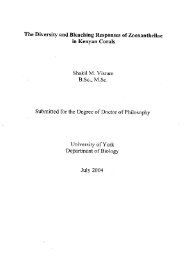
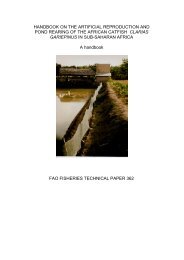

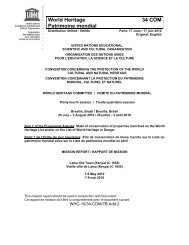
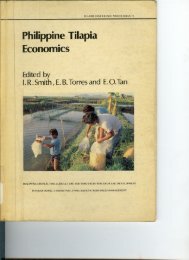

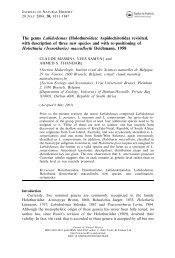
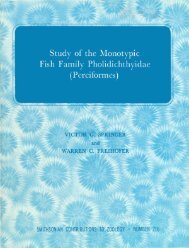
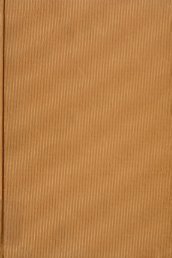
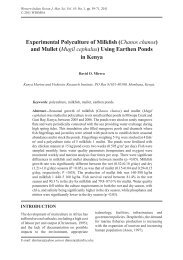
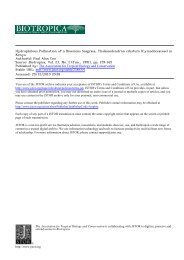
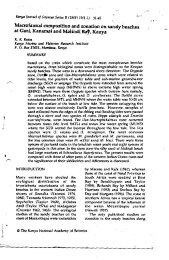
![MSc. Thesis - Lang'at[1].pdf](https://img.yumpu.com/10016993/1/184x260/msc-thesis-langat1pdf.jpg?quality=85)
